One of the proposed benefits of social media is the capture of knowledge that’s shared, taking the tacit and making it explicit. But really, how do we do this? I think we need to separate out the real from the ideal.
The underlying premise is that we have an enlightened organization that’s empowering collaboration, communication, problem-solving, innovation, etc (what I’m beginning to term ‘inspiration’ in all senses of the word) by providing a social media infrastructure, learning scaffolding, and a supportive culture. Now, all these people are sharing, but are we, and can we be, leveraging that knowledge?
The obvious first answer is that by sharing it with others, it’s being leveraged. If information is shared with the relevant people, it’s been captured for organizational use by being spread appropriately. That’s great, and far too few organizations are facilitating this in a systematic way. However, I’m always looking for the optimal outcome: not just the best that is seen, but the best that can be. So how can we go further?
The typical response is using data mining that focuses on semantic content: systematically parsing the discussions, and using powerful semantic tools to attempt to capture, characterize, and leverage information systemically. (Hmm, you could map out the knowledge propositions, and link them into coherent chains and then track those over time to see significant changes, even regularly re-sort to see if different perspectives are changing…oh, sorry, got carried away, enough adaptive system designing :).
In terms of social media systems, while there are analytics available, semantics are not part of it, as far as I can see. Further, I searched on social media mining, and found out that the first international workshop will be happening in November, but it’s not happened yet. There’s an interesting PhD thesis on the topic from UMaryland, but it’s focused on blogs and recommendations. In other words, it’s not ready for prime time.
The point is, that machine learning and knowledge mining mechanisms are in our future, but not our present. Don’t get me wrong, there are huge possibilities and opportunities here, but they’re a ways off. So, are we back to the best that can be? I want to suggest one other possibility. The systemic mechanisms are nice because, set up properly, they run regardless, but there’s another approach, and that’s human processing. For all the advances in technology, our brains are still pretty much the most practical semantic pattern matching engines going. So how would that work?
Well, let’s go back to the role that learning professionals play. We’ve already looked at how they could change as learning units take over responsibility for the broader picture of learning in the organization. Learning professionals need to be nurturing social learning, and that means being in there, monitoring discussions for opportunities to draw out other members, spark useful feedback, develop skills, and more.
Well, they also can and should be looking for outcomes that could be redesigned/redeveloped/reproduced for broader dissemination. They should be monitoring what’s happening and looking for information that’s worth culling out and distilling into something that’ll really bring out the impact of that information. Turning information into knowledge and even wisdom!
Yes, that’s a greater responsibility (though it’s also fun; you shouldn’t be in the learning space if you don’t love learning!). It’s a new skill set, but I’ve already argued that. The world’s changing, and the status quo won’t last long anyway. So, while you can just allow and hope that individuals will perceive the value of the information created, and even facilitate by encouraging people to participate in all the relevant communities (which will likely cross role, product/service, and more), there’s a step further that’s to the benefit of the organization and the learners.
We’ll steadily build support for that process, but it will be facilitated, and advanced, by individual practice to complement, supplement, and inform the mechanistic approaches. Don’t ignore this role; plan for it, prepare for it, and skill for it. Responsibility for recognizing should be shared, so that the individuals in the network are also doing it (for example, retweeting valuable information), and that’s a learning skill that should be developed.
Here’s hoping you find this valuable!
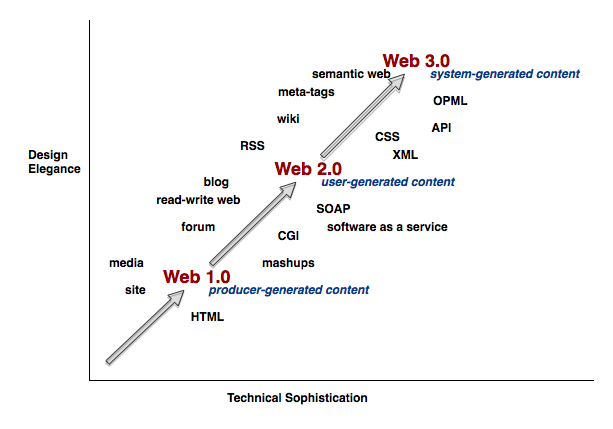 However, if we think about web 2.0 as user-generated content, we can think about 1.0 as producer-generated content. The original web was what people savvy enough (whether tech or biz) could get up on the web. The new web is where it’s easy for anyone to get content up, through blogs, photo-, video-, and slide-sharing sites, and more.
However, if we think about web 2.0 as user-generated content, we can think about 1.0 as producer-generated content. The original web was what people savvy enough (whether tech or biz) could get up on the web. The new web is where it’s easy for anyone to get content up, through blogs, photo-, video-, and slide-sharing sites, and more.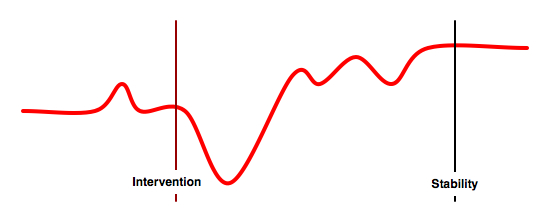
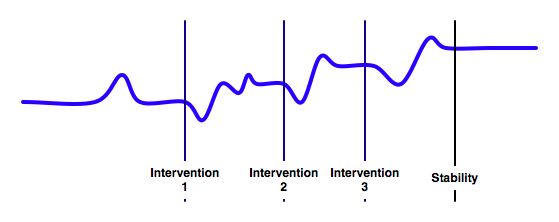 By having smaller introductions that break up the intervention, you decrease the negative effects. The point is to take small steps that make improvements instead of a monolithic change.
By having smaller introductions that break up the intervention, you decrease the negative effects. The point is to take small steps that make improvements instead of a monolithic change.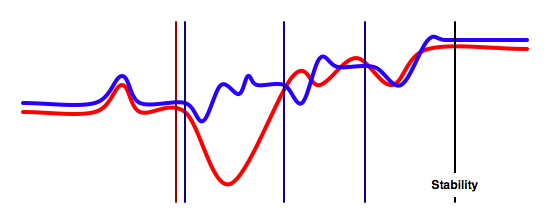 The goal is to maximize improvements while minimizing disruption, and doing so in ways that capitalize on previous efforts and existing infrastructure. To do this really requires understanding how the different components relate: how content models support mobile, how performance support articulates with formal learning and social media, and more. And, of course, understanding the nuances of the underpinning elements and how they are optimized.
The goal is to maximize improvements while minimizing disruption, and doing so in ways that capitalize on previous efforts and existing infrastructure. To do this really requires understanding how the different components relate: how content models support mobile, how performance support articulates with formal learning and social media, and more. And, of course, understanding the nuances of the underpinning elements and how they are optimized.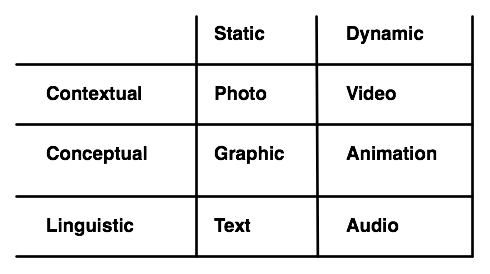 I’ve had a slight blindspot for photos and video because I peg the ‘conceptual’ meter. I recognize the value, though I don’t play with the files enough (tho’ I took a digital audio/video editing course more than a decade ago, and recently edited home videos for my wife’s birthday). Photos and videos are really good for contextualizing, and that’s particularly valuable for examples (and practice).
I’ve had a slight blindspot for photos and video because I peg the ‘conceptual’ meter. I recognize the value, though I don’t play with the files enough (tho’ I took a digital audio/video editing course more than a decade ago, and recently edited home videos for my wife’s birthday). Photos and videos are really good for contextualizing, and that’s particularly valuable for examples (and practice).